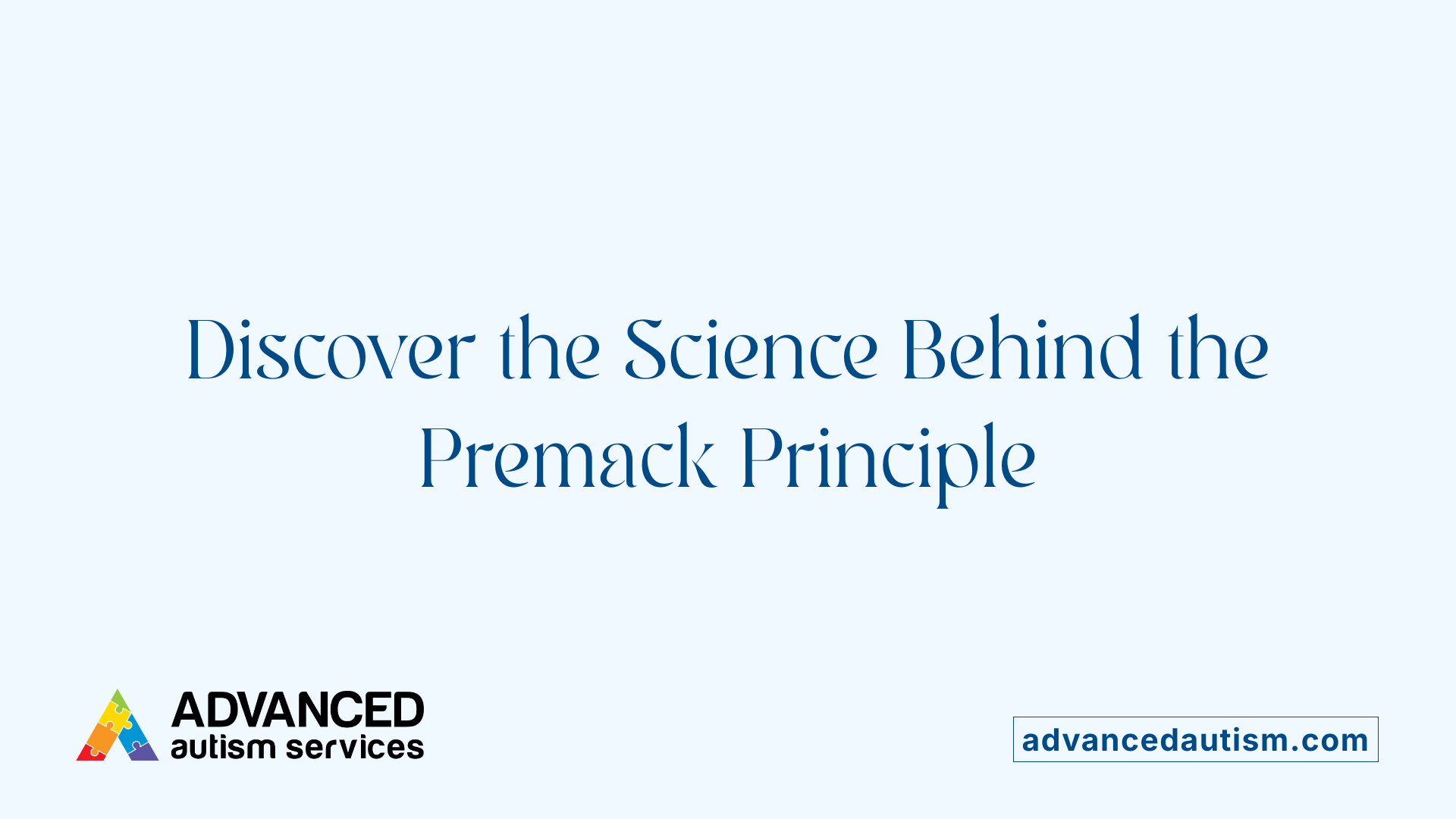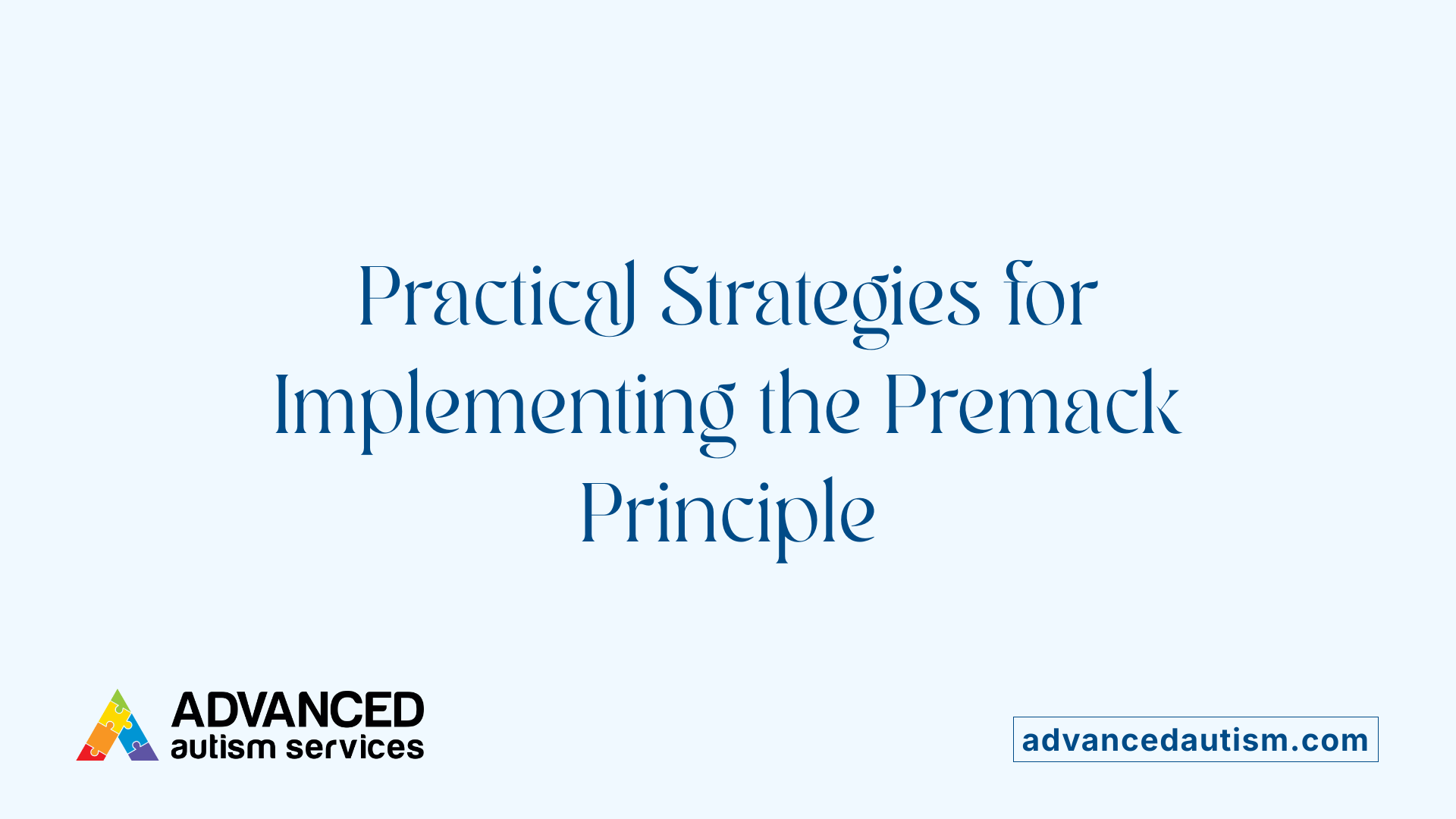Exploring the Premack Principle's Role in Behavior Modification
Understanding the Premack Principle offers valuable insights into motivation and behavior management, especially within therapeutic contexts such as Applied Behavior Analysis (ABA) for autism. This article unpacks the foundations, applications, and significance of the Premack Principle, highlighting its integration in ABA therapy to foster positive behavioral changes.
Defining the Premack Principle: The Science of Behavioral Reinforcement

What is the Premack Principle?
The Premack Principle, often called the relativity theory of reinforcement, explains how behaviors that an individual is more likely to perform (high-probability behaviors) can serve as a reward to encourage the performance of less likely behaviors (low-probability behaviors). This means that a preferred activity is used as a kind of incentive to promote engagement in a less desired task. For example, a child may be allowed to play only after completing their homework, leveraging their desire to play as motivation for completing schoolwork.
Understanding High-Probability vs. Low-Probability Behaviors
High-probability behaviors are actions a person naturally prefers and would engage in frequently without external prompts—such as playing a game or eating a favorite snack. Low-probability behaviors are ones they are less inclined to do, such as chores, studying, or cleaning up. The Premack Principle pairs these two so the desirable behavior reinforces the less attractive one.
Origins and Foundations of the Premack Principle
David Premack developed this concept through experimental research with animals and humans, including rats, chimpanzees, and children. His studies showed that allowing access to a more probable behavior could effectively reinforce a less probable one. Influenced by B.F. Skinner's work on behaviorism, Premack's experiments highlighted how natural preferences could be strategically used to shape behavior.
This principle has since influenced behavioral interventions and remains foundational in applied behavioral analysis, particularly for children requiring tailored motivational strategies.
Applying the Premack Principle in ABA Therapy for Autism

What is Applied Behavior Analysis (ABA) therapy?
Applied Behavior Analysis (ABA) therapy is a science-based method focused on understanding and modifying behavior by using learning principles and environmental factors. It aims to improve socially important behaviors such as communication, social skills, and daily living abilities while reducing challenging behaviors. ABA is especially effective for individuals with autism spectrum disorder (ASD).
ABA programs use techniques like positive reinforcement and data-driven tools including the Antecedent-Behavior-Consequence (A-B-C) model to customize interventions for each individual. These individualized plans are developed and overseen by trained professionals, such as Board Certified Behavior Analysts (BCBAs), and involve collaboration with family and caregivers to support skill generalization across different settings.
How is the Premack Principle used in ABA therapy?
The Premack Principle plays a vital role in ABA by pairing less preferred behaviors with more preferred activities to motivate engagement. For example, a child might be encouraged to complete a less favored task, like practicing communication skills or completing a worksheet, by promising access to a highly preferred activity afterward, such as playing with a favorite toy or watching a preferred video.
Implementation typically uses clear "first, then" instructions and sometimes visual tools like first/then boards to communicate the behavioral sequence. This method leverages the natural likelihood of performing the more preferred behavior to reinforce the less probable task, making it an effective motivational tool in therapy sessions.
What are the benefits of the Premack Principle for individuals with autism?
Applying the Premack Principle within ABA offers numerous benefits for individuals with autism. It encourages positive behavior reinforcement by making the learning process more engaging and promoting skill acquisition. This approach helps develop new, desirable behaviors by naturally linking them to activities the individual enjoys.
The principle is adaptable and can be tailored to each child's unique preferences, enhancing motivation and persistence. It supports improving areas like communication, social interaction, and adaptive functioning by increasing participation in less preferred but necessary activities.
Furthermore, this technique can help decrease challenging behaviors by substituting them with structured, reinforcing activities. Positive reinforcement through preferred behaviors fosters independence and creates lasting behavior change.
Overall, the Premack Principle is an important component of ABA therapy, making interventions more effective and enjoyable for children with autism while supporting their developmental progress.
How the Premack Principle is Practically Implemented in Therapy

Pairing High- and Low-Probability Behaviors
In therapy, the Premack Principle is practically implemented by linking less desired activities (low-probability behaviors) to more preferred ones (high-probability behaviors). For example, a child may be encouraged to complete homework before enjoying playtime, or to eat vegetables before having dessert. This pairing effectively motivates the individual to first engage in the less preferred task to gain access to the preferred one.
Implementation Strategies
Successful use of the Premack Principle starts with identifying which behaviors have higher or lower probabilities of occurring naturally. Therapists then structure activities so that the less probable behavior must occur first, followed by the more probable behavior as a reward. Consistency and natural linkage between these behaviors help in establishing positive habits over time.
Use of 'First, Then' Language and Visual Aids
Clear communication is vital to the principle’s success. Using simple "first, then" phrases, such as "First finish your homework, then you can play," helps individuals understand expectations and outcomes. Visual tools like first/then boards or charts reinforce this message, particularly in children or individuals with developmental disabilities, offering a tangible reference that guides behavior.
Motivating Operations Affecting Reinforcement
The effectiveness of reinforcement under the Premack Principle can vary depending on motivating operations. Establishing operations (EO) temporarily increase the value of the high-probability behavior as a reinforcer, making it more effective in encouraging the low-probability behavior. Conversely, abolishing operations (AO) reduce the reinforcer’s value, potentially lowering motivation. Awareness and management of these factors help therapists optimize outcomes in behavioral interventions.
Common ABA Techniques Complementing the Premack Principle

What are the common techniques used in ABA therapy?
Applied Behavioral Analysis (ABA) therapy employs several techniques designed to encourage positive behavior change, often alongside the Premack Principle.
One widely used approach is Discrete Trial Training (DTT), which involves breaking down skills into small, structured steps. Each trial provides clear instructions and immediate reinforcement, making learning manageable and effective.
Positive reinforcement is central to ABA. It rewards desired behaviors by adding a favorable outcome, increasing the likelihood that these behaviors will recur. The Premack Principle fits naturally here, as more probable behaviors serve as reinforcers for less probable ones.
Modeling involves demonstrating behaviors for the child to imitate. This helps in teaching new skills through observation, enhancing engagement.
Task analysis breaks complex tasks into smaller, teachable parts, making difficult activities easier to learn step-by-step.
Another vital technique is Natural Environment Teaching (NET), which promotes skill acquisition in everyday settings through play and routine activities, making learning more relevant and generalizable.
Additional strategies include prompting and fading to shape behaviors, behavior chaining to link sequences of actions, extinction to reduce undesired behaviors, and functional communication training (FCT) to improve communication skills. All these are grounded in behavioral principles aimed at producing lasting positive changes.
Together with the Premack Principle, these ABA techniques create a comprehensive framework for motivating, teaching, and reinforcing beneficial behaviors in children, particularly those with autism spectrum disorder.
Customizing ABA Therapy Using the Premack Principle
How is ABA therapy tailored to individual needs?
Applied Behavior Analysis (ABA) therapy, especially when using the Premack Principle, is highly personalized to meet each child's unique requirements. The process begins with a thorough assessment that includes direct observations and valuable input from the family. This helps identify the child’s strengths, challenges, and specific goals.
A Board Certified Behavior Analyst (BCBA) designs a treatment plan with clear, measurable objectives focusing on skill development and reducing undesired behaviors. Functional behavior assessments delve into understanding why challenging behaviors occur, enabling the design of effective intervention strategies.
Reinforcement strategies are individualized by identifying high-probability (preferred) and low-probability (less preferred) behaviors for the child. This allows therapists to apply the Premack Principle effectively—using preferred activities as rewards to encourage less desirable tasks. For example, a child might be prompted to complete a learning task before accessing a favored game.
What role does family involvement play?
Family participation is crucial in ABA therapy. Caregivers are trained to consistently implement reinforcement techniques at home, ensuring skills learned in therapy generalize across environments. Visual aids like first/then boards and clear language help families apply the Premack Principle naturally, enhancing motivation and consistency.
How are interventions monitored and adapted?
Ongoing data collection tracks the child's progress, allowing the BCBA to make informed adjustments to the treatment plan. This dynamic approach ensures that the therapy remains aligned with the child’s evolving needs, preferences, and motivational states. For instance, changes in motivating operations might alter reinforcer effectiveness, requiring new preferred activities to maintain engagement.
By integrating assessment, individualized goal setting, family collaboration, and continuous monitoring, ABA therapy employing the Premack Principle creates a flexible, supportive environment that promotes meaningful behavioral improvements tailored to each child.
Evaluating the Effectiveness and Limitations of the Premack Principle
What evidence supports the effectiveness of ABA therapy in autism treatment?
Applied Behavioral Analysis (ABA) therapy, incorporating techniques like the Premack Principle, is well-supported by scientific research as an effective intervention for children with autism spectrum disorder (ASD). Numerous clinical trials and meta-analyses show that ABA can significantly enhance communication, social skills, and adaptive behaviors. Children who undergo ABA often demonstrate improved language capabilities and better daily living skills over the long term.
Clinical applications and research evidence
The Premack Principle is frequently used in ABA to motivate children by reinforcing less desirable behaviors with more preferred activities. For example, a child may be encouraged to complete difficult tasks by promising access to a favored activity afterward. This technique has been extended beyond autism treatment, with studies illustrating its usefulness in behavior modification and even clinical settings like weight loss programs.
Criticisms and alternative theories
Despite practical successes, the Premack Principle faces criticism for limited empirical support and occasional inconsistencies. Critics argue that it does not fully explain reinforcement mechanisms in all cases, leading to alternative theories such as Response Deprivation Theory. This alternative emphasizes the role of deprivation states rather than relative activity probabilities in motivating behavior.
Systematic reviews and insight for practitioners
Systematic reviews of the Premack Principle’s applications help clarify its effectiveness and boundaries. While the principle offers a valuable framework, these analyses suggest practitioners should consider individual differences and motivating operations that influence reinforcement value. Tailoring ABA therapy through an understanding of these nuances ensures the Premack Principle is applied most effectively within behavioral interventions.
The Premack Principle: A Motivational Cornerstone in Behavioral Therapy
From its roots in foundational behavioral research to its integral application in ABA therapy, the Premack Principle serves as a powerful tool for motivation and behavior change. By strategically linking preferred and less preferred activities, therapists and caregivers can encourage skill acquisition and positive behavioral outcomes, especially in individuals with autism. While research continues to refine its theoretical basis and clinical efficacy, the Premack Principle remains a vital concept in behavior analysis that supports personalized and effective therapeutic interventions.
References
- Premack principle in ABA therapy: 5 ways to implement
- Premack's principle (relativity theory of reinforcement)
- Premack Principle ABA Examples and Implementation
- the Premack Principle in Psychology: Definition and ...
- Applications of the Premack Principle: A Review ...
- The effectiveness of applied behavior analysis program ...
- Efficacy of Interventions Based on Applied Behavior ...
- How ABA Therapy Can Improve Your Child's Life



